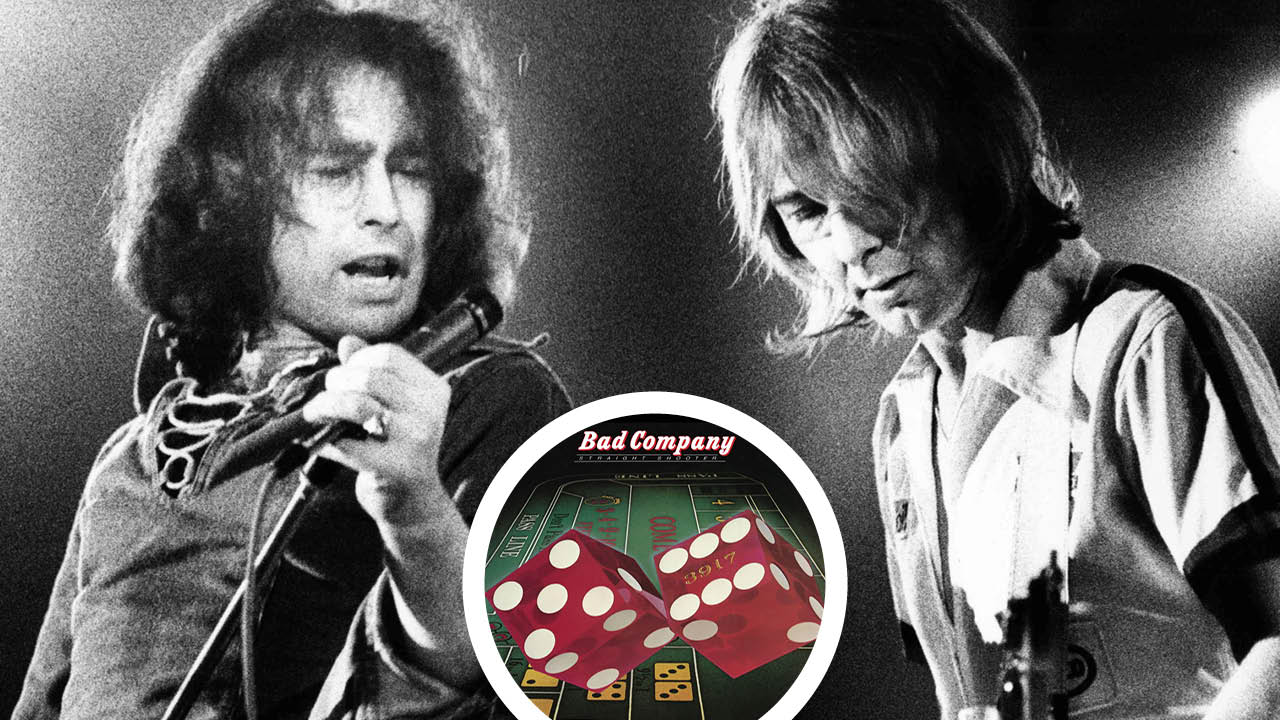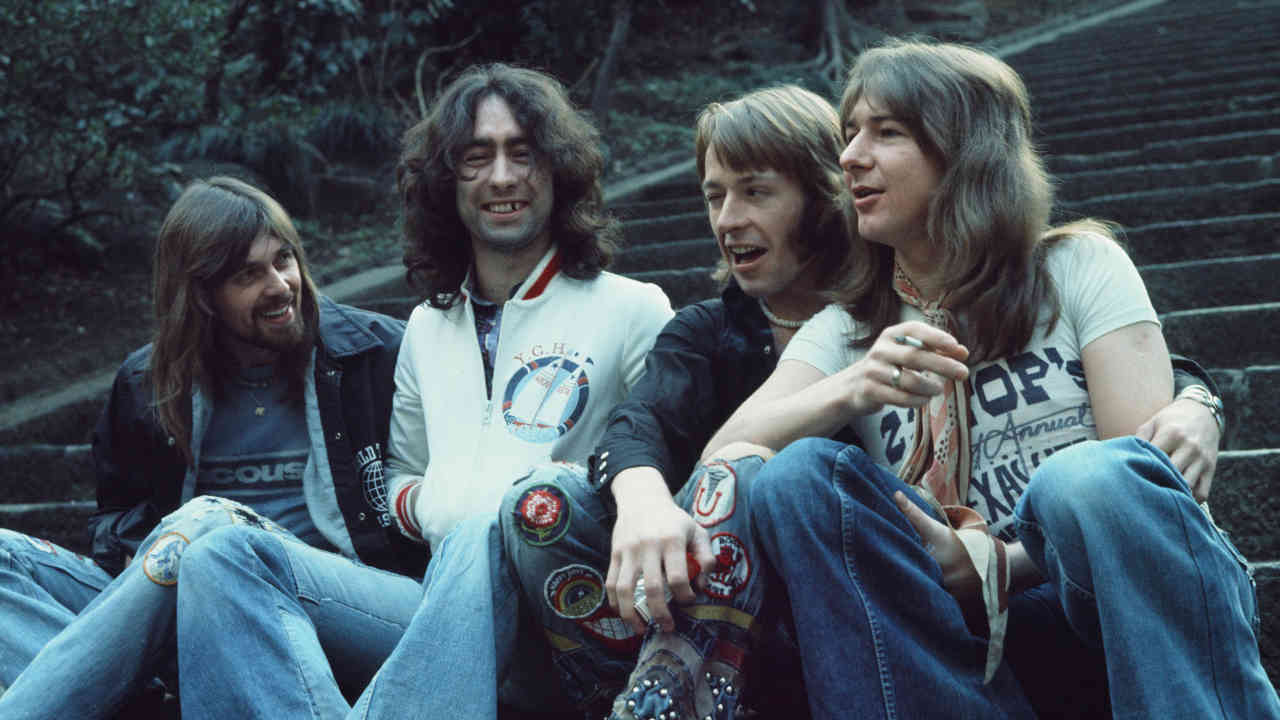
Three months after the release of their first album, Bad Company were at work on Straight Shooter, a record that would come out less than a year after that landmark debut. On it would be two songs, Feel Like Makin’ Love and Shooting Star, that would join Can’t Get Enough and Ready For Love in the classic rock’n’roll canon. And all that Bad Company had time for in between was the road, where they further tightened that classic, deceptively freewheeling sound.
Bad Company weren’t unique in their speed or their greatness either. In 1975, the year of Straight Shooter, Led Zeppelin released Physical Graffiti, their sixth album in as many years (and those six were half-decent, weren’t they?). Black Sabbath offered their first five between 1970 and 1973; Deep Purple released In Rock in 1970, Fireball in ’71, Machine Head in ’72, Who Do We Think We Are in ’73, and Burn and Stormbringer in 1974. Genesis put out Trespass, Nursery Cryme, Foxtrot and The Lamb Lies Down On Broadway between 1970 and ’74. Jethro Tull were gunning out eight albums in eight years, culminating in 1975’s Minstrel In The Gallery. Queen managed Queen II, Sheer Heart Attack and A Night At The Opera between March 1974 and the end of the following year.
It was a remarkable time. Sure, records were shorter and the touring cycle occupied months rather than years, and the musical areas into which these bands were expanding were virgin, unexplored. But imagine how it must have been to walk into a record shop and, almost by the week, go home with records like these…
All of the years since have altered our reading of a record like Straight Shooter. As its title suggests, it was never going to be The Dark Side Of The Moon (another record that slipped out in ’73 – its successor, Wish You Were Here, was imminent). Instead, Straight Shooter’s principles were entirely in keeping with the mood and personalities of its creators: after some difficult times marked by druggy comedowns and fracturing relationships in their previous bands, they were experiencing the simple joys of making music with like-minded souls. Guitarist Mick Ralphs and singer Paul Rodgers had struck up a writing partnership based around Ralphs’ gift with a riff and Rodgers’ peerless voice. Drummer Simon Kirke’s own writing was becoming a counterpoint to the impeccable rhythm section he was creating with bassist Boz Burrell.
“I must say it felt very natural,” Rodgers told Classic Rock in 2012. “I don’t mean to sound arrogant, but it felt like we had the goods. We’d already paid our dues in Free and Mott and [King] Crimson, so we knew what we were doing.”
The good vibes had been cemented in Boston on the final night of their American tour, when, with a typical flourish, Peter Grant stopped them just as they were about to go on stage to present them each with a US gold disc for Bad Company.

Back in the UK, they were ready to repeat the trick. In place of Headley Grange, the Hampshire haunted house that imbued their debut with such strange magic, came Clearwell Castle, a Gothic pile built for Thomas Wyndham in 1728 and restored in the 1950s by a Blackpool baker and his family. Set deep in the Forest of Dean, its imposing twin towers are lined with battlements; its entrance lies beneath a forbidding portcullis.
The little studio had really kicked into gear a couple of years before Bad Company arrived. Deep Purple wrote Burn, their first post-Ian Gillan record, there in 1973, before recording it in Montreux. Black Sabbath arrived at the Castle still in the grip of the coke habits that had produced Vol 4 out in California, but which then led to a fruitless and destructive attempt to write another record at a house in Bel Air. Fractious and under pressure, Tony Iommi retreated to the castle dungeons and almost immediately came up with what would be described as “the riff that saved Black Sabbath” – the main section of Sabbath Bloody Sabbath. Led Zeppelin visited Sabbath, and would return in 1978 to rehearse parts of In Through The Out Door. And had Mick Ralphs not left Mott The Hoople for Bad Company, he would have pitched up in the Forest of Dean just a few months later as Ian Hunter and co hired the Castle for some writing sessions.
The place had an atmosphere of its own. Its terraced gardens sat in the peace of the forest, a contrast to the thick walls of the dank dungeons that had inspired Tony Iommi. With their body clocks set to ‘tour’, Bad Company began working through the nights and sleeping away the days. They began by going through their bag of ideas, some pre-dating the formation of the band, others worked up on the long stretches of road they’d covered in the months since their debut’s release.
There was already a sense of pressure, both artistic and commercial. The press had been quick to label Bad Company a ‘supergroup’, even though Free were yet to acquire the sheen of legend, Mott were in the grip of a glam-rock identity crisis and King Crimson were essentially a vehicle for the offbeat brilliance of Robert Fripp. It was a fashionable catch-all, but not a label that particularly suited the band, who were defiantly un-starry. Only Rodgers truly fit the mould: tight jeans, hairy chest and that louche, long-haired charisma at the mic stand.
Yet it brought with it certain expectations that were compounded by the out-of-the-box success of their debut. They were already bigger than any of the bands that had spawned their constituent parts, and adding to the heavyweight reputation was their manager Peter Grant, who, when he wasn’t crowbarring Led Zeppelin into the financial stratosphere, was offering Bad Company the benefits of his brutal genius. Grant had given the boys gold discs at the end of that first tour, but the truth was that sales were already kicking up towards platinum and everyone from record company execs to humble fans in out-of-the-way towns were anxious to know whether the band could do it all again.
Add to that ‘second album syndrome’, a relatively unexplored phenomenon at the time, but one with principles that held true. Bad Company had no time to plan and write and absorb the lessons of their journey so far. Instead, they had to pull together a worthy follow-up at little more than the drop of a hat.
Rodgers looked back into his bag of tricks. He thought back to a song he’d begun writing when he was with Free when they’d been gigging in San Francisco. It was a simple idea with some gentle, acoustic opening chords. To them he’d added a lyric that seemed to fit: ‘Baby, when I think about you/I think about love…’ (Well, he had been in the city of peace and love at the time…)
“I’d begun it a long time before,” Rodgers remembered when he spoke to Mick Wall. “And then when I sat down with Mick at Clearwell going through ideas, I showed him the opening chords and the opening line. I said, ‘It just needs something,’ and he went, ‘Well, try this…’ And I went, ‘Well I feel like makin’ love…’ and we said, ‘Right, that’s good, we’ll put that one down.’”
It was more than good, of course. Deep down in Rodgers’ voice was that great well of soulfulness. He was introducing to rock music something that would become a staple of its development – the classic rock voice that had some echoes of a Motown smoothie, and others of the existential rock’n’roll loner.
It was deeply atmospheric, and it was the kind of thing that sold to girls as well as guys. Paul Rodgers, with those big, puppy-dog eyes, did it for the chicks as well as their boyfriends, who no doubt took note of the effect he was having on their girls. It gave Bad Company an edge that the more baroque and experimental of their contemporaries didn’t quite have.
Writing at such speed meant there was inevitably little stylistic difference between their first and second records. Good Lovin’ Gone Bad, the cocks-out-on-the-table tune that would ultimately open Straight Shooter, was a brother to Can’t Get Enough, while Simon Kirke’s Weep No More and Anna both stood in the shadow of Paul Rodgers’ Seagull. The excellent Deal With The Preacher was cut from the same cloth as Bad Company or Movin’ On.
The record’s other highlight was Shooting Star, a song that elevated Straight Shooter towards its status as a nascent classic. It was another Paul Rodgers tune, apparently drawn straight from his experiences in the last years of Free, when their brilliant, benighted guitarist Paul Kossoff edged towards personal oblivion. Given some distance, it’s apparent that the lyric can be applied to many of the rock’n’roll casualties that were beginning to pile up: Morrison, Joplin, Hendrix and other, future members of that uninviting club.
“It was about Paul and a lot of other people too,” Rodgers told Classic Rock. “I thought, ‘Wow, a lot of people die in the music business, don’t they?’ I mean, it’s not like it’s a war zone, but you looked around and there was Jimi Hendrix, Janis Joplin, Jim Morrison… And of course Koss was included in that.”
The band had handled the production of Bad Company themselves, but they’d been joined on the sessions by a young American engineer called Ron Nevison, who had worked with The Who on Quadrophenia and was fresh from the mighty Physical Graffiti (where the song The Rover would come with the somewhat damning credit ‘guitar lost courtesy of Nevison’).
Like Bad Company, Nevison was at the start of an enduring career: his future would take in everyone from miscreants like Ozzy Osbourne and UFO to the crystalline audio perfection of Heart and Survivor. Nevison was a character, and he made sure that the long night-time sessions had the same juice and swing that those at Headley Grange had brought.
Straight Shooter sounds like a progression for a band operating in fairly narrow parameters: it’s clean, hard and sleek. The finished record came in another Hipgnosis sleeve, its tumbling dice a good fit for the music within. This was straight-up rock’n’roll, expertly done, by and for the people. “I still say the first three years of Bad Company were the happiest of my life,” Simon Kirke would reflect decades later.
The album sold out of the box, powered by the US Top 40 hit Good Lovin’ Gone Bad, and then the Top 10 smash Feel Like Makin’ Love. It hit No.3 on both sides of the Atlantic and quickly went platinum.
“I suppose the word is ‘overwhelming’,” Mick Ralphs would remember. “It was all a bit much at first. I don’t think we took it that seriously. We thought, ‘This is alright. Don’t know how long it’s going to last, but it’s good at the moment.’”
The band were about to enter the classic phase of the 1970s global rock star: private planes, massive houses, garages full of cars and, of course, that on-the-road rocket fuel, coke and booze.
“The coke thing, Paul quit all that in ’76,” revealed Simon Kirke. “But we all indulged. It never got in the way of a performance. But what happened just after Straight Shooter was that we were on the carousel of album-tour, album-tour and we were starting to get…”
It’s not a sentence that really needs finishing. The next record, Run With The Pack, would bring Bad Company to their early musical peak and, along with their first two albums, would cement their status as stars not just of the era, but the genre.
Originally published in Classic Rock Presents Bad Company







